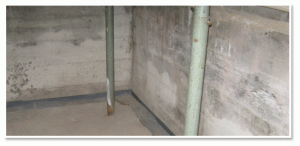 In my last discussion I focused attention on basements and crawlspaces where there may not be liquid water but where the relative humidity frequently reaches above 70%. As we discussed it all comes down to temperature. The humid outside air in summer is cooled to the prevailing temperature of around 60 F in a basement, automatically increasing the relative humidity. If the relative humidity outside is 50%, it may increase to 70-80% in a cool basement or crawlspace. That puts the air in the range of the dry-tolerant molds. Basements and crawlspaces are susceptible to mold activity simply because they are, well, basements and crawlspaces.
In my last discussion I focused attention on basements and crawlspaces where there may not be liquid water but where the relative humidity frequently reaches above 70%. As we discussed it all comes down to temperature. The humid outside air in summer is cooled to the prevailing temperature of around 60 F in a basement, automatically increasing the relative humidity. If the relative humidity outside is 50%, it may increase to 70-80% in a cool basement or crawlspace. That puts the air in the range of the dry-tolerant molds. Basements and crawlspaces are susceptible to mold activity simply because they are, well, basements and crawlspaces.
So what happens when there is additional moisture from wall and floor infiltration? This problem adds to the humidity level and can also directly affect those susceptible food sources such as drywall, carpet and fiberglass insulation. When these materials get and stay damp, mold growth is almost a certainty. This is especially true with carpet and insulation, which hold moisture like sponges. Wet carpet is a very common source of massive mold activity.
When there is chronic water infiltration, even mechanical dehumidification will be ineffective. It is difficult to keep up with continuing water intrusion, kind of like shoveling against the tide. It is far more effective to eliminate the moisture intrusion and get the basement dry.
So how is water management accomplished? The first things most folks look at are the grade outside and the behavior of the roof leaders. In most cases, however, there is not a lot that can be done about the grade. Yes, low spots that pond water should be filled and every effort should be made to encourage water to flow away from the house foundation. This includes improving the discharge of the roof leaders. I have some roof leaders at my home that discharge 50 feet away from the house. The sorry truth, however, is that the water will still soak into the ground and affect the foundation as groundwater during very wet stretches of weather.
I did everything I could to improve the flow of water outside my home and I still was taking water at times. The only option left was to address the water situation from the inside. At this point many folks think of the term waterproofing. They think that if we can only get the basement watertight, the problem will be solved. And so they apply all kinds of stuff on the basement walls, including tar, epoxy, waterproof paint, plaster and sometimes even a second wall. The outcome is that water almost always continues to come in.
This befuddles most normal people because it just doesn’t seem to make sense. If we can make our ships and large boats watertight why can’t we do the same for our houses? The short answer, as my navy friend reminded me, it that ships are not even remotely watertight. The key to keeping a ship afloat is to pump water out faster than it comes in. And this is the key to understanding what waterproofing actually means.
Waterproofing is not an effort to keep water out, which we know by long experience will fail. Waterproofing is the science of capturing water at its point of entry and escorting it out of the basement, just like the bilge pumps do for ships. And by far the most common point of entry is the joint where the foundation and floor slab meet the footing. We call this joint a cold joint, since the footing, foundation and slab are all installed at different times. This means that the cement for the first component has already set when the second component is added. The bond between the two components is therefore imperfect. No matter how much tar is applied on the outside, eventually the cold joint will be exposed to water and allow some to enter.
The obvious location to intercept the water, therefore, is at this joint. How do we intercept water? We use a drain pipe just like you would use to capture water outside, except that the pipe is installed in the floor slab so that it is at the joint. The key to efficiently capturing water is to place the pipe right at the joint. The only way one can place a pipe at this joint is to use a square pipe. That is precisely the product that has made Basement Technologies famous.
The patented Water Trek Aqua Route® basement drainage system is the most effective foundation drain on the market. It is the only high performance drain that sits on the footing joint and accepts water from both the foundation wall and from below the slab. Because of its location, the drain system basically gives intruding water no choice. By the time the water penetrates the joint it is already in the drain. Its design is elegant simplicity.
The design of the Water Trek Aqua Route® drain has several other advantages. Because it is installed against the bottom foundation wall, weep holes that are drilled into the bottom foundation block flow directly into the drain. This serves to evacuate accumulated water in the block wall and efficiently relieve pressure on the foundation wall. Not only does this capture the liquid water, but it also tends to dry out the wall, reducing humidity levels in the basement.
The second fundamental advantage of the design of the Water Trek Aqua Route® drain is its accessibility for flushing and cleaning. Because the drain is installed on the relatively shallow footing, access ports allow for inspection, cleaning and flushing. Because of its access for cleaning and flushing, the Water Trek Aqua Route® never clogs.
The Water Trek Aqua Route® drain system is a significant improvement over the more primitive round pipe footing systems that dominated the market in the 1960’s and 70’s. Since these systems use round pipe, they could only be installed at the bottom of the footing. The theory was that this location would be effective because groundwater from below the slab would be captured. The round pipe systems proved to be prone to failure.
One reason for their failure rate is their inability to capture water from the foundation wall. Water that intrudes through the wall joint has a long way to travel to get to the drain pipe and is just as likely to find the floor surface instead. Even well designed round pipe systems have this fundamental flaw.
The second common reason for failure is clogging. When a pipe is 12-18” below the slab and clogs, the only available repair is excavation. After having excavated and replaced many round pipe footing systems, I can testify that it is much easier and cheaper to simply flush out the Water Trek Aqua Route® drain.
A basement drain system is a substantial undertaking that should provide a lifetime of worry free performance. This is one area where it decidedly does not pay to invest in a lesser product. Choose the right system and do the job once.
If you have any questions about mold activity, please call 609-371-2489.
AIR Consulting Services, LLC
301 E Ward Street
Hightstown, NJ 08520
Phone: 609.371.2489
